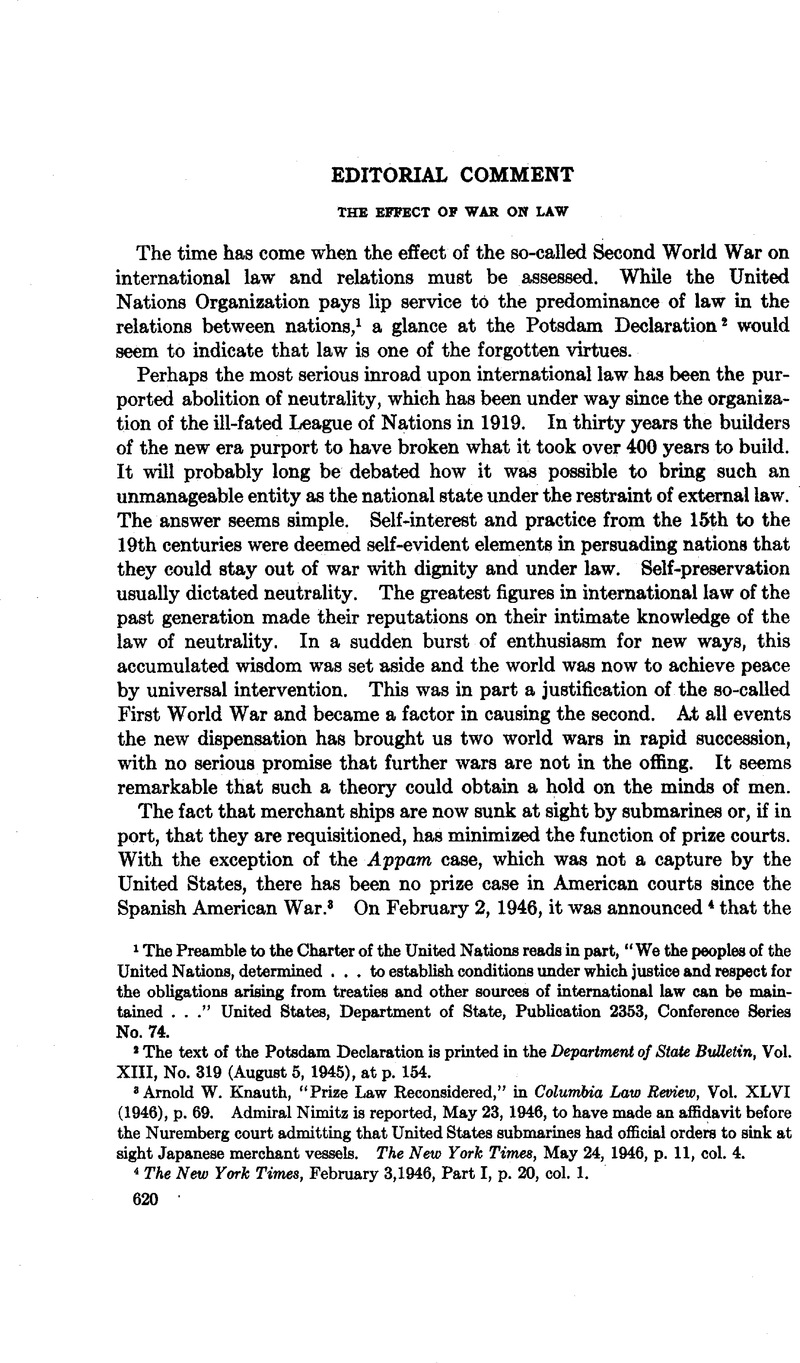Article contents
The Effect of War on Law
Published online by Cambridge University Press: 20 April 2017
Abstract

- Type
- Editorial Comment
- Information
- Copyright
- Copyright © by the American Society of International Law 1946
References
1 The Preamble to the Charter of the United Nations reads in part, “We the peoples of the United Nations, determined … to establish conditions under which justice and respect for the obligations arising from treaties and other sources of international law can be maintained …” United States, Department of State, Publication 2353, Conference Series No. 74.
2 The text of the Potsdam Declaration is printed in the Department of State Bulletin, Vol. XIII, No. 319 (August 5, 1945), at p. 154.
3 Knauth, Arnold W., “Prize Law Reconsidered,” in Columbia Law Review, Vol. XLVI (1946), p. 69 CrossRefGoogle Scholar. Admiral Nimitz is reported, May 23, 1946, to have made an affidavit before the Nuremberg court admitting that United States submarines had official orders to sink at sight Japanese merchant vessels. The New York Times, May 24, 1946, p. 11, col. 4.
4 The New York Times, February 3,1946, Part I, p. 20, col. 1.
5 The Preamble to the Charter of the United Nations states as one of its aims : “ to ensure, by the acceptance of principles and the institution of methods, that armed force shall not be used, save in the common interest, …” Department of State, Publication 2353, Conference Series No. 74.
6 Another aim is “to unite our strength to maintain international peace and …’’Same.
7 According to the Preamble of the Charter, the peoples of the United Nations are determined “to reaffirm faith in fundamental human rights, in the dignity and worth of the human person, in the equal rights of men and women and of nations large and small …” Same.
8 The Potsdam Declaration, referring to private property, announced agreement on reparations as follows: “Reparation claims of the U.8.S.R. shall be met by removals from the zone of Germany occupied by the U.S.S.R. and from appropriate German external assets. … The reparation claims of the United States, the United Kingdom and other countries entitled to reparations shall be met from the western zones and from appropriate German external assets.” The U.S.S.R. was also to receive from the western zones certain equipment as specified. The Control Council was authorized to take appropriate steps “to exercise control and the power of disposition over German-owned external assets not already under the control of United Nations which have taken part in the war against Germany.” Department of State Bulletin, Vol. XIII, No. 319 (August 5, 1945), pp. 156,157.
See also the Final Act and Annex of the Paris Conference on Reparation in same, Vol. XIV, No. 343 (January 27, 1946), p. 114; the Law on Vesting and Marshaling of German External Assets in same, Vol. XIV, No. 347 (February 24,1946), p. 283; and the Plan of the Allied Control Council in same, Vol. XIV, No. 354 (April 14, 1946), p. 636.
9 See also the Report of the Crimea Conference in Department of State Bulletin, Vol. XII, No. 295 (February 18, 1945), p. 213.
10 The New York Times, May 22, 1946, p. 13, col. 2.
11 Above, note 8.
12 “Shall Switzerland Surrender Its German-Owned Property?”, by F. X. Peter, of Lucerne, Switzerland, translated by Dr. Konrad Gutman, New York, 1946.
13 Karl Loewenstein, Political Reconstruction, New York, 1946. See also this Journal, Vol. 40 (1946), p. 164, note 8. 14 The New York Times, April 20, 1946, p. 1, col. 6.
- 1
- Cited by




